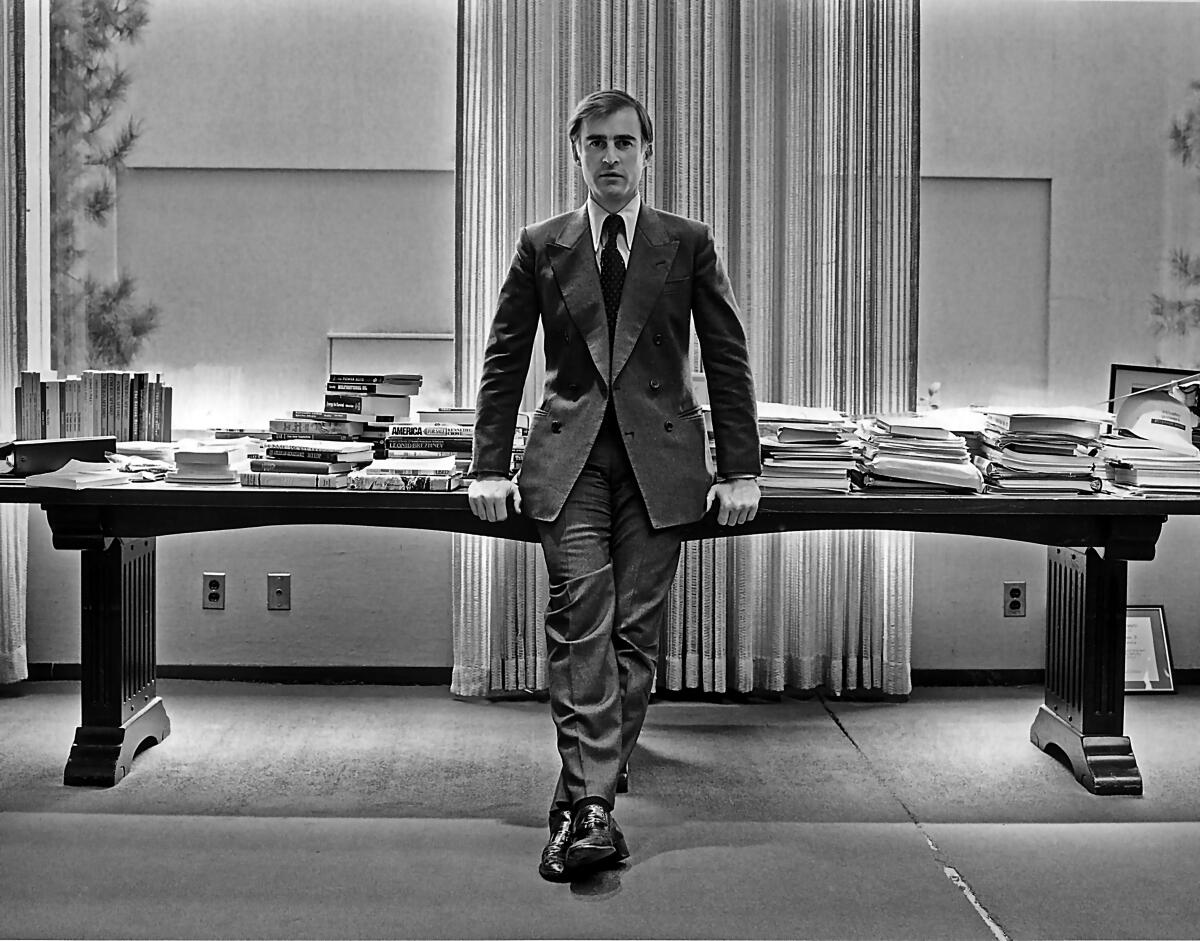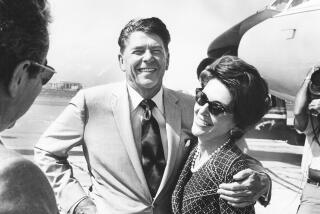Review: ‘Jerry Brown: The Disrupter’ is a revealing look at the California politician

- Share via
Anyone who takes civics seriously and lives in a world of facts cannot help but be dismayed by the mediocrity of much of what passes for contemporary politics — one cannot even say governance, so little are some elected officials interested in it.
And so we turn with a mixture of relief and longing to the latest edition of the biographical series “American Masters,” “Jerry Brown: The Disrupter.” Premiering Friday on PBS, it concerns the California governor (and secretary of state, and attorney general, and mayor of Oakland); whatever you think of his politics, there’s no denying his seriousness, dedication and singularity.
“American Masters” has focused typically on cultural and pop cultural figures but is dedicating the current season to “Thought Leaders: A series on innovative American thinkers,” including episodes on Bella Abzug, William F. Buckley Jr., Cesar Chavez and Daniel Patrick Moynihan. (Though, for having famously dated Linda Ronstadt — a pairing that found its way onto the covers of People and Us magazines — Brown might be considered pop-culture-adjacent.)
Television goes on this fall with some pretense of normalcy. Our critics weigh in on some of the genres that will dominate the fall schedule.
And Brown, certainly, is a man of many thoughts. The film, directed by Marina Zenovich, finds him, young and old both, consistently honest and honestly consistent, even in his apparent evasions — a person true to an ever-evolving self.
“I’m trying to get you to explain who you are,” a frustrated Zenovich (or so I assume) asks him at the top of the film. “How would you describe yourself?”
“There’s no kind of ‘who’ existing in abstraction,” Brown responds.
“Just describe yourself.”
“No, I can’t do that.”
Such recalcitrance — or intellectual rigor — aside, Brown makes a fit and fascinating subject. A temperamental outsider, he spent most of his life in the mainstream of politics, from his 1970 election as California secretary of state to the end of his unprecedented and surely unrepeatable fourth term, and second stint, as its governor in 2018. Though all his offices were held in California, where his father, Edmund G. “Pat” Brown, was governor before him, Jerry Brown was a national figure; he ran for president three times, unsuccessfully and, one might say, poorly — choosing the wrong years to run, more than once getting into the race so late that he didn’t appear on some primary ballots. (“It was doomed from the beginning,” he said about his 1980 bid, against incumbent Jimmy Carter, “but I didn’t understand that. You can have an idea, and you can be clear about it, and certain about it, and be completely wrong.”)
Anyone who was around when Brown first became governor, in 1975 at age 36, will be familiar with his well-publicized quirks. He declined to live in the governor’s mansion, preferring a spartan apartment across from the capitol that suited the seminarian he had been (and presaged the student of Zen he would become); sold off the governor’s executive jet and flew commercial; and refused the usual limousine in favor of a car from the motor pool. “There’s something ascetic about him,” says his friend, actor-activist Peter Coyote. “He didn’t care about any of the accouterments of power; he wanted to do things.” Dubbed “Governor Moonbeam” by Chicago newspaper columnist Mike Royko, who was no fan, Brown took it as a compliment, connoting vision and a willingness to dream.
“The machinery of government runs on,” Brown reflects, “and the moves to be made by a governor are relatively limited, and when you realize you can have a Republican governor or a Democratic governor, depending on which one, the script is written and all you have to do is perform it. I wanted to think, what could I do as governor that if I weren’t there would not be done.” He midwifed the country’s first farm labor bill, and was decades ahead of his time on renewable energy and climate change. “Those are physical laws and you just can’t disobey them with impunity, so you’ve got to get on the side of nature.”
After his second, less productive term as governor, two failed campaigns for the Democratic nomination for president and an unsuccessful run for the Senate, Brown took a break from politics — fully intending to return “in some interesting capacity” but taking some time to work on himself. He moved to Japan to study Zen. He went to India, where Mother Teresa told him to work in a home for the dying, which he did: “In the face of misery, one person just by taking the first step can really make a change and not be overwhelmed by cynicism or despair or the enormity of the problem.”
During a third grassroots campaign for the Democratic nomination in 1992, Brown railed against politicians from both parties “debating over marginal change,” which, not unusually, did not endear him to the leaders of his own party. He moved to Oakland, started a radio show, ran for mayor, served two terms and was instrumental in improving the city’s fortunes; he ran for attorney general and won; then he served another two terms as governor, leaving the state — deep in debt when he took office — with a surplus of several billion dollars.
“The Disrupter” — both Brown’s sister, Kathleen, a former state treasurer, and Arnold Schwarzenegger, who was governor when Brown was attorney general, use the phrase to describe him — is a typical mix of archival news footage and photographs and new conversations with Brown, his friends and associates, and journalists including Times columnist George Skelton, who has covered politics nearly as long as Brown has been in it.
Its tone is admiring — as the series title implies, “American Masters” documentaries tend to be valentines, and there are more supporters than critics onscreen here. (Well, there aren’t really any critics.) But it isn’t fawning, and if it’s necessarily incomplete as to the accomplishments, failures and controversies of a long career, it effectively renders its shape — including the low points that helped refine Brown, and redefine him. He can seem severe, and fiercely focused (“It was never a light touch with Jerry,” says sister Kathleen), but he’s also funny; he was clearly ambitious, yet suspicious of ambition as divorced from purpose. In office, he was a practical sort of radical, willing to fight his own party in order to make things work; he and Schwarzenegger seemingly got on well together. Says the Governator: “Young people can learn from Jerry not to be put in a box, and they can learn from Jerry not to go cater to your party but to cater to the people.”
Says Brown: “Anytime you say, ‘Am I going to do it for political reasons, personal or what’s right?’ I think I am ... as all of us are, a complex of motives, and everything we do is an admixture of many thoughts and premises oftentimes we don’t even understand.”
- Share via
Watch L.A. Times Today at 7 p.m. on Spectrum News 1 on Channel 1 or live stream on the Spectrum News App. Palos Verdes Peninsula and Orange County viewers can watch on Cox Systems on channel 99.
More to Read
The complete guide to home viewing
Get Screen Gab for everything about the TV shows and streaming movies everyone’s talking about.
You may occasionally receive promotional content from the Los Angeles Times.









